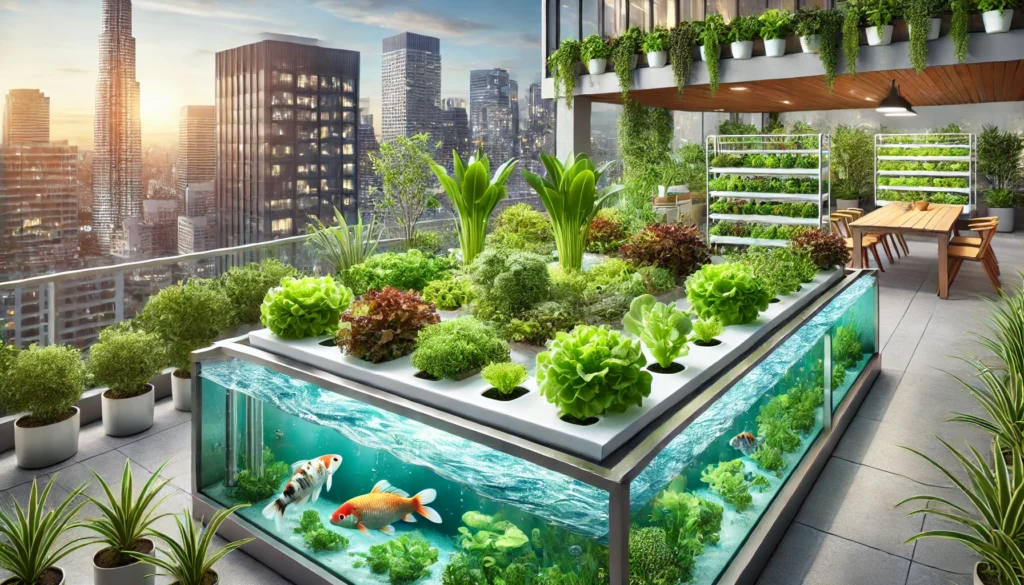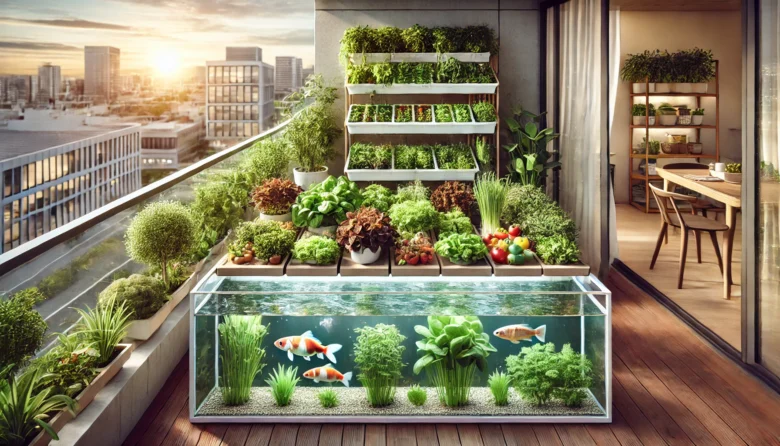Finding fresh and locally grown food in Indian cities can be challenging. But what if we could grow our vegetables and fish right in the heart of our urban spaces? Enter aquaponics—a revolutionary system that combines aquaculture (raising fish) and hydroponics (growing plants in water) to create a sustainable and efficient way to produce food. Let’s dive into the world of aquaponics and explore how it can transform urban food production in India.
What is Aquaponics?
Aquaponics is a method of food production that uses a closed-loop system to cultivate fish and plants together in a symbiotic environment. In this system, fish waste provides essential nutrients for the plants, and the plants, in turn, filter and purify the water for the fish. This natural cycle creates a self-sustaining ecosystem that can produce fresh, organic food in urban settings.
In India, where urbanization is rapidly increasing, aquaponics offers a practical solution to food security and sustainability. It requires less space and water than traditional farming and can be done on rooftops, balconies, or small urban gardens.
How Aquaponics Works
The aquaponics system comprises three main components: the fish tank, the grow bed, and the water pump. Here’s how it works:
Fish Tank
Fish are raised in the tank, and their waste products, rich in ammonia, are excreted into the water. Common fish used in aquaponics include tilapia, catfish, and Indian carp.
Grow Bed
The water from the fish tank is pumped into the grow bed, where beneficial bacteria convert the ammonia into nitrates, essential nutrients for the plants. The plants absorb these nutrients, effectively cleaning the water.
Water Pump
The clean, filtered water is recirculated into the fish tank, creating a continuous loop. This closed system conserves water and creates a balanced environment for fish and plants.

Benefits of Aquaponics
Aquaponics offers numerous advantages, making it an ideal choice for urban food production. Here are some key benefits:
Space Efficiency
Aquaponics systems can be set up in small spaces, making them perfect for urban environments where land is limited. Vertical farming techniques can further maximize the use of available space.
Water Conservation
Aquaponics uses up to 90% less water than traditional soil-based agriculture. The closed-loop system recycles water, reducing the need for constant irrigation.
Organic and Chemical-Free
Aquaponics relies on natural processes, eliminating the need for chemical fertilizers and pesticides. This results in fresh, organic produce that is healthier for consumers and the environment.
Year-Round Production
Aquaponics systems can produce food year-round in controlled environments, regardless of seasonal changes. This ensures a consistent supply of fresh vegetables and fish.
Reduced Carbon Footprint
By growing food locally, aquaponics reduces the need for transportation and packaging, significantly lowering the carbon footprint associated with food production.
Aquaponics in India
Several initiatives and companies in India are pioneering aquaponics to promote sustainable urban agriculture. Here are a few notable examples:
Aquaponic Farming India
Aquaponic Farming India is a Bangalore-based startup that specializes in setting up aquaponics systems for homes, schools, and commercial spaces. It offers turnkey solutions and training programs to help individuals and organizations adopt aquaponics.
GreenEssence
GreenEssence, based in Pune, designs and installs custom aquaponics systems tailored to urban dwellers’ needs. It also conducts workshops and provides resources for those interested in learning more about sustainable farming practices.
Urban Kisaan
Urban Kisaan, a Hyderabad-based company, focuses on vertical farming, hydroponics, and aquaponics. It provides urban residents with fresh, locally grown produce while promoting sustainable agricultural practices.
The Water Garden
The Water Garden, a social enterprise in Kerala, combines aquaponics with community engagement. They work with local schools and communities to set up aquaponics systems, providing fresh food and educational opportunities.
How to Start Your Own Aquaponics System
Starting your aquaponics system may seem daunting, but with the proper guidance and resources, growing your food can be a rewarding and sustainable way. Here’s a simple guide to get you started:
Research and Plan
Begin by learning about the basics of aquaponics. Understand the different components, types of systems, and the specific needs of the fish and plants you intend to grow. Planning is crucial to ensure your system is well-designed and efficient.
Choose the Right Location
Select a suitable location for your aquaponics system. It should have access to adequate sunlight for the plants and be protected from extreme weather conditions. Rooftops, balconies, and terraces are ideal spots in urban settings.
Set Up the System
You can purchase a ready-made aquaponics kit or build your system using basic materials. Ensure the fish tank, grow bed, and water pump are correctly installed and connected. Make sure the system is well-aerated and has a reliable water source.
Select Fish and Plants
Choose fish species that are hardy and well-suited to your local climate. Tilapia, catfish, and Indian carp are popular choices. For plants, leafy greens like lettuce, spinach, and herbs are excellent for beginners.
Monitor and Maintain
Monitor the water quality, pH levels, and temperature of your system regularly. Feed the fish appropriately and ensure the plants receive adequate nutrients. Routine maintenance is essential to keeping the system balanced and productive.
Success Stories of Aquaponics in India
Urban Greens, Delhi
Urban Greens has successfully implemented aquaponics systems on the rooftops of residential buildings in Delhi. Their projects have provided residents with fresh, organic produce and promoted sustainable living in the city.
Farmizen, Bangalore
Farmizens in urban Bangalore use aquaponics to grow various vegetables and fish. Their community-supported agriculture model allows residents to subscribe and receive fresh produce directly from the farm, reducing their carbon footprint.
EarthBox, Mumbai
EarthBox has created compact, modular aquaponics systems suitable for small urban spaces in Mumbai. Their innovative designs have allowed city dwellers to grow food sustainably, even in limited spaces.
Conclusion
Aquaponics represents a promising solution for sustainable urban food production in India. By combining aquaculture and hydroponics, this innovative system offers a way to grow fresh, organic food while conserving resources and reducing environmental impact. As more urban residents embrace aquaponics, we can look forward to healthier cities and a more sustainable future.
So why not try aquaponics? Whether you have a small balcony or a spacious rooftop, you can start growing your food sustainably and contribute to a greener, more self-sufficient urban landscape.
Author’s Note:
Thank you for reading! I hope this blog has inspired you to explore the possibilities of aquaponics. We can create a more sustainable future, one urban farm at a time.
G.C., Ecosociosphere contributor.
References and Further Reading:
- Aquaponic Farming India
- Urban Kisaan
- Mattox, R. (2023). The Dwelling and The Shed: Redefining the Homestead. https://core.ac.uk/download/572714908.pdf
- Economic Analysis of Commercial Aquaponic Production Systems — University of Kentucky. https://scholars.uky.edu/en/projects/economic-analysis-of-commercial-aquaponic-production-systems-3
- Choosing the Right Fish and Plants for Your Aquaponics System – FriendlyAquaponics. https://friendlyaquaponics.com/choosing-the-right-fish-and-plants-for-your-aquaponics-system/
- Growing Aquaponic Squash – FriendlyAquaponics. https://friendlyaquaponics.com/growing-aquaponic-squash/
- How Does Aquaponics Work For Kids? – Classified Mom. https://www.classifiedmom.com/how-does-aquaponics-work-for-kids/
- From Traditional Farming to Aquaponics: A Transition Guide – FriendlyAquaponics. https://friendlyaquaponics.com/from-traditional-farming-to-aquaponics-a-transition-guide/
- Introduction to Aquaponics Diploma Course – Harley Oxford. https://www.harleyoxford.com/product/introduction-to-aquaponics-diploma-course/
- Discovering the Beauty of Singha Park: A Guide to Exploring Thailand’s Largest Agricultural Park. https://doubletakesblog.com/discovering-the-beauty-of-singha-park-a-guide-to-exploring-thailands-largest-agricultural-park/
- Sustainable living Archives – My Plants grow. https://myplantsgrow.com/category/sustainable-living/
- How to choose the best substrate for your aquarium – The Aquarium Pet. https://theaquariumpet.com/how-to-choose-the-best-substrate-for-your-aquarium/
- The Ideal Fish Tank Setup For Office Spaces. https://ourmarinespecies.com/wp-content/cache/page_enhanced/ourmarinespecies.com/c-fishes/the-ideal-fish-tank-setup-for-office-spaces/_index_slash.html_gzip
- A Deadly Metro Incident Highlights America’s Infrastructure Deficit | The Fiscal Times. https://www.thefiscaltimes.com/2015/01/14/Deadly-Metro-Incident-Highlights-America-s-Infrastructure-Deficit




